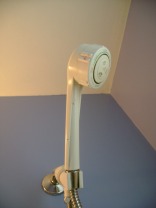Low-Flow Technologies
It All Adds Up!

By installing a low flow showerheads and faucet aerators, a household can reduce their water consumption and water heating costs by 50% (FYP, 2008). The amount of hot water used for showering can add up, a ten minute shower can use approximately 190 litres of hot water with a conventional showerhead, not to mention that it contributes to approximately 25% of household energy costs (B.C. Hydro, 2004).
How it Works:
There are two main types of low-flow appliances: aerating, which mixes water into the stream, and non-aerating, which adds pressure to the stream in order to maintain heat and a steady stream (FYP, 2008).
Faucet Aerators: A screen is placed at the front of the faucet where the water comes out, also called the faucet head; this screen decreases the flow of water by adding additional air to the water flow (FYP, 2008).
Low- Flow Showerheads: These showerheads operate a variety of ways; usually they either draw air in or use compressed air to add pressure to the water, creating a high speed spray in order to give the feel of a stronger water flow (FYP, 2008). This makes it seem as strong as a conventional showerhead, even though less water is coming out.
It All Adds Up:
Low-flow showerheads and faucet aerators are readily available at your local hardware store and are relatively affordable, usually ranging in price between $8-$50, and $5-$10 respectively (FYP, 2008).
Whereas conventional showerheads use between 15-19 litres of water per minute, low flow showerheads only use between 6-9 litres; some low-flow models conserve even more by incorporating a valve shut-off switch that stops the water while the user soaps-up (B.C. Hydro, 2004). The savings may not seem outstanding per minute, but when calculated annually it can add up. For example, a family of 3 can take approximately 1000 showers per year, if they were using a conventional showerhead this would add up to 190,200 litres, while had they been showering with a low-flow model they use approximately 95,200 litres, a savings of 95,000 litres annually (B.C. Hydro, 2004).
A large decrease in the amount of water also means that less heated water is being used, which significantly decreases energy costs. If the water is heated by natural gas, the annual cost savings would be approximately $190 (B.C. Hydro, 2004).
References:
Flex Your Power. (2008). Residential Overview – Product Guides: Showerheads.
Available Online: http://flexyourpower.com/res/tools/products_results.html?id=100160
B.C. Hydro. (2004). Low-Flow Shower Heads. Available Online: http://www.bchydro.com/powersmart/elibrary/elibrary699.html
Photo Credit: Shoni Litinsky
